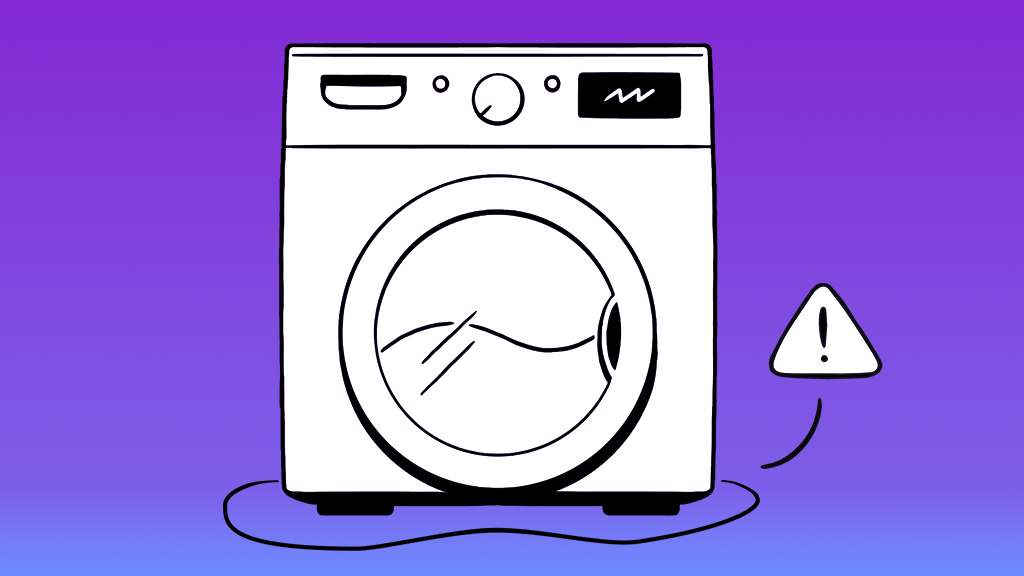Dryers are supposed to quietly churn out warm, fluffy clothes, so if your machine sounds like a bad rock band, something is wrong. Wear and tear, loose parts, or even a blocked fan can all lead to humming, thumping, and rattling.
Don't worry though. If your dryer is making noise and you're not sure what to do, you're in the right place. Asurion Experts are trained in and experienced with repairs for all major appliances—including fixing a leaking washer, cleaning a refrigerator water line, and unclogging a dishwasher that isn't draining—so they're proven pros at solving precisely this kind of problem.
Here's their guide to troubleshooting dryers making loud noises.
Before you start, unplug your dryer
For many of these issues, you'll need to take off the dryer drum and cabinet, so always remember to unplug your machine before you begin. You don't want to get electrocuted. Also, if you have a gas-powered dryer or one that's hardwired to your home's electrical system, contact a professional for help.
What to do if your dryer is making squeaky noises
If your dryer is making squeaking noises, there are a couple of issues to look out for.
Check the drum rollers and axles
Drum rollers are small wheels that support the drum as it turns. Most machines have two rollers in the rear, and some have two more in the front of the drum. When the rollers (and the axles they spin on) are damaged, broken, or worn flat, they can squeak, squeal, and even thump.
If your rollers and axles look worn out, loose, or don't spin freely, it's time for new ones. Even if one axle is the problem, it's best to replace all of them. Here's how to check:
- Open the dryer door, and look at the back wall. If there's a gap between the drum and the wall, you likely need to install new drum rollers.
- To know for sure, unplug your dryer, unscrew the dryer lid (or back depending on your model), remove the belt from the dryer drum, and turn the drum by hand. If one or more of the rollers get stuck or don't turn freely, you may need to replace them.
- Note that if your dryer is hardwired or gas-powered, you may need to contact a professional for help.
- If the roller axles wobble when you spin the drum rollers, it's time for new axles.

Psst... Got 2 minutes?
That’s how long it takes to get a care plan personalized for you:
✓ Coverage for thousands of devices ✓ Fast, quality fixes
�✓ Hands-on help when you need it
Check the idler pulley
The spring-loaded idler pulley puts tension on the drum belt, ensuring it doesn't slip as your appliance spins. If the pulley wears out, you'll hear squeaky noises, typically as soon as you turn on your machine.
To diagnose the problem:
- Unplug the dryer and disconnect the air vent duct if needed. If your dryer is hardwired or gas-powered, you may need to contact a professional for help.
- Remove the front or lower access panel.
- Find the idler pulley by following the route of the drive belt to a wheel on a moveable bracket mounted near the drive motor.
- Remove the drive belt, then try to rotate the pulley. Pay attention to how easily it turns. If it doesn't rotate smoothly or if you see physical wear and tear, you'll need a new idler pulley.
Since this is an advanced repair, reach out to an appliance expert for help—and stop using your dryer until it's fixed.
What to do if your dryer is making thumping noises
Thumping noises can be caused by socks, washcloths, or heavy objects caught inside the dryer drum. But if you don't see any of those items trapped in the drum, keep reading.
Check the drive belt
The drive belt is a long, thin piece of equipment that helps the drive motor spin the drum. When the drive belt gets worn out or frayed, it often creates a thumping noise as it tries (and fails) to turn the drum.
To check your drive belt:
- Unplug your dryer from the power supply. If your dryer is hardwired or gas-powered, you may need to contact a professional for help.
- Remove the lower access panel.
- Look for the drive belt—it wraps around the drum, tension pulley, and drive motor.
- If you see signs of wear, like cracks or fraying, contact an appliance expert for help.
Check the drum rollers
These components can cause a thumping noise for two different reasons.
- If you haven't used your dryer for a while, it may have developed a flattened roller, which can cause your dryer to thump as the drum spins. If this is the problem, you'll have to replace the roller.
- When drum rollers get worn out, they lose their solid connection with the drum, causing that thumping noise. In this case, contact an expert for a replacement.
Check the drum seal
Made of a felt-like material, this component creates a cushion between the drum and front and rear bulkheads that prevents excess air from entering the dryer. Over time, however, it wears out. And as it does so, clothing can get caught in the gap as the drum turns, leading to that thump.
Another sign the drum seal is the problem: Your clothes come out of the machine with rips or black marks they didn't have when they went in. To check your dryer's drum seal:
- Unplug your dryer from the power supply. If your dryer is hardwired or gas-powered, you may need to contact a professional for help.
- Move the dryer away from the wall and open the dryer cabinet. Check your dryer's manual for instructions.
- With the drum exposed, examine the seal for damage. If you see signs of wear and tear, it will need to be replaced. If your machine has more than one seal, it's best to replace them all at once.
What to do if your dryer is making grinding noises
If your dryer makes a grinding noise, you could have a worn-out drum bearing or drum glides. Here's how to figure out which issue you have. In both cases, it's best to contact an expert for help with replacing parts.
Check the drum glides, slides, or pad
Drum glides are plastic pieces that support the drum. As the dryer rotates, it slides on the glides, but when they wear out, the drum makes a grinding noise as it turns. To figure out if your drum glides show wear and tear, remove the dryer cabinet and examine them. If your dryer is hardwired or gas-powered, you may need to contact a professional for help.
Check the drum bearing
Found at the back of the dryer, behind the drum, this component is typically a ball and socket or a shaft connected to a sleeve bushing. When it wears out, the drum rubs against the back of the casing, creating a grinding or squealing noise.
To determine whether this is your problem, remove the dryer cabinet and take the drive belt off. If you have trouble rotating the drum, or you hear that grinding (or squealing) noise, you'll need to contact an appliance expert.
What to do if your dryer is making squealing noises
That squealing noise coming from your dryer could be due to the drum bearing or drive belt. Either way, you'll need help from a repair professional.
Check the drum bearing
As mentioned in the previous section, a worn-out drum bearing can create a squealing or grinding noise.
Check the drive belt
Drive belts don't just cause thumping. As the drive belt wears, it can become loose, which can lead to squealing. Follow the steps in the previous drive belt section to check for signs that it’s time for a replacement.
What to do if your dryer is making rumbling noises
If you hear a loud rumbling noise coming from your dryer, the blower wheel may be responsible. This component circulates air in the drum and blows it out through the rear exhaust vent. If it's loose, off-balance, or blocked by lint or debris, the blower wheel will make a rumbling or thumping noise.
There are two ways to determine if this is your issue. (Remember, if your dryer is hardwired or gas-powered, you may need to contact a professional for help.)
- Since the blower wheel often continues rotating after the dryer is turned off, you may be able to diagnose the problem by turning off the dryer and listening for the noise. If it continues, the blower wheel is your issue.
- You can also look for the blower wheel behind the front or rear panel, attached or threaded onto the motor shaft. When the blower wheel works properly, it will turn the motor and drum. If you try to spin the drum or blower wheel and all three components don't spin or you hear that rumbling noise, contact an expert about replacing the blower wheel.
What to do if your dryer is making rattling noises
In your dryer, baffles or lifters tumble and fluff clothes and prevent them from sticking to the inside of the drum as they dry. If loose change or other small objects get trapped in your machine, you'll hear a rattling noise.
Check for coins under the baffles or lifters, but keep in mind that when those parts get loose or worn out, they can also cause that rattling. So if your machine makes a loud noise, contact an appliance pro to replace the worn or loose baffles or lifters.
What to do if your dryer is making multiple noises
If you hear an orchestra of weird noises coming from your dryer, you likely have a problem with the drive motor. This component turns the dryer drum and blower wheel, but if the bearings need to be replaced, you'll hear squealing. If the motor pulley is loose, you'll hear rattling. If there's a faulty switch, you'll hear a humming noise.
You'll have to remove the dryer cabinet and possibly the dryer drum to check out the drive motor, so contact an appliance expert for help.
Reliable protection for the major appliances you rely on
When your appliances don't work, we do. With Asurion Appliance+®, you get hassle-free coverage and 24/7 troubleshooting support for your current and future appliances—no matter the brand or where you bought them. But it’s not the only care plan we offer. Take our 2-minute quiz to find the right care plan for your appliances and tech, or learn more about how you can get total peace of mind with Asurion Appliance+.




